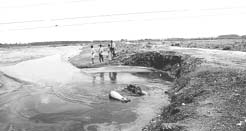Reviving a river
 the Supreme Court has directed the Delhi government that a minimum flow of 353 cusecs per second be maintained in the Yamuna river throughout its course. The court was hearing a petition by the Pani Morcha, a non-governmental organisation ( ngo ), which said that a minimum flow of water in the river could be an immediate step towards reviving it. Instead of recharging ground aquifers, the Yamuna was not only depleting the city's groundwater but also polluting it. Besides, the decreased flow of water is not able to flush away the effluents.
the Supreme Court has directed the Delhi government that a minimum flow of 353 cusecs per second be maintained in the Yamuna river throughout its course. The court was hearing a petition by the Pani Morcha, a non-governmental organisation ( ngo ), which said that a minimum flow of water in the river could be an immediate step towards reviving it. Instead of recharging ground aquifers, the Yamuna was not only depleting the city's groundwater but also polluting it. Besides, the decreased flow of water is not able to flush away the effluents.
Meanwhile, to overcome the water crisis in Delhi, the Indian National Trust for Art and Cultural Heritage ( intach ) and Pani Morcha, both ngo s , and the Central Ground Water Authority ( cgwa ) have come up with proposals to recharge the ground water. Interestingly, all the proposals pending with the Delhi government deal with traditional water harvesting systems to revive the Yamuna river. The proposal based on studies conducted by the ngo s reveal that there is enough water in the capital. Proper utilisation is all that is required.
intach was commissioned by the Delhi government to study the revival of Yamuna's ancient channels and roof-top water harvesting. According to the report, the water harvesting and recycling would yield 150 mega gallons per day ( mgd ) (100 per cent of the current demand) and 450 mgd, respectively. The estimated cost of the project is Rs 1,385 crore which is half the cost of getting the same quantity of water from the Himalayas as proposed by the State.
Similarly, Pani Morcha has submitted to the government a five-page sewage treatment plan for recharging the Yamuna. It proposes to treat the sewage which is being pumped into the Yamuna and use it for recharging the groundwater. It has suggested biological sewage cleaning for the Yamuna. The cgwa plan is of extraction and replenishment of groundwater to augment the city's water supply.
On May 14, the court had stated that the water will be used only for pure environmental reasons and will not be used for consumption. The minimum flow is expected not only to reduce pollution in the river but also to recharge the ground water. The states responsible for maintaining the flow would be Haryana, Himachal Pradesh, Uttar Pradesh, Rajasthan and Delhi. The above chief secretaries of the five states' are to decide on their respective share of the water.
The apex court gave its verdict on the basis of recommendations made by a high-powered committee set up by the court in 1996. The committee
Related Content
- Order of the High Court of Madhya Pradesh regarding Swarn Rekha river revival, Gwalior, Madhya Pradesh, 26/11/2024
- Order of the National Green Tribunal regarding water management, Delhi, 22/01/2021
- Affidavit filed by the Amballoor Grama Panchayat on Konothupuzha river pollution, Ernakulam, Kerala, 23/10/2020
- River ecology: an assessment of the impact of COVID-19 lockdown
- Report on encroachment of Yamuna flood plains, Mathura, Uttar Pradesh, 01/09/2020
- Order of the National Green Tribunal regarding water management in Delhi, 03/02/2020
